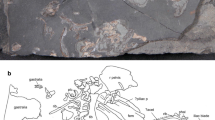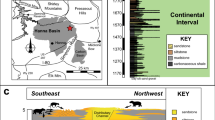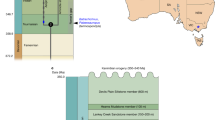Abstract
The earliest four-limbed vertebrates, or tetrapods, lived between 370 million and 354 million years ago, during the Late Devonian period, and typically had more than five digits (polydactyly)1. We have discovered that a preaxial form of polydactyly, in which extra digits are positioned anterior to the first digit, has unexpectedly re-emerged in a marine reptile from the Early Triassic period about 242 million years ago — the overall morphology of both the manus and pes closely resemble those of the earliest tetrapods. Until now, no post-Devonian tetrapod has been found with a comparative type of polydactyly, so the new amniote provides a striking example of convergent evolution.
This is a preview of subscription content, access via your institution
Access options
Subscribe to this journal
Receive 51 print issues and online access
$199.00 per year
only $3.90 per issue
Buy this article
- Purchase on SpringerLink
- Instant access to full article PDF
Prices may be subject to local taxes which are calculated during checkout

Similar content being viewed by others
References
Coates, M. I. & Clack, J. A. Nature 347, 66–69 (1990).
Gould, S. J. Nat. Hist. 1/91, 22–29 (1991).
Radhakrishna, U. et al. Am. J. Genet. 65, 645–655 (1999).
Danforth, C. H. Am. J. Anat. 80, 143–171 (1947).
Shubin, N., Tabin, C. & Carroll, S. Nature 388, 639–648 (1997).
Lebedev, O. A. Doklady Academii Nauk SSSR 278, 1470–473 (1984).
Motani, R. J. Vert. Paleontol. 19, 28–41 (1999).
Clack, J. Gaining Ground: The Origin and Evolution of Tetrapods (Indiana Univ. Press, Bloomington, 2002).
Shubin, N. H. & Alberch, P. Evol. Biol. 20, 319–387 (1986).
Edwards, J. J. Am. Zool. 29, 235–254 (1989).
Li, J.-L., Liu, J., Li, C. & Huang, Z.-X. Vert. PalAsiat. 40, 241–244 (2002).
Author information
Authors and Affiliations
Corresponding author
Ethics declarations
Competing interests
The authors declare no competing financial interests.
Additional information
brief communications is intended to provide a forum for brief, topical reports of general scientific interest and for technical discussion of recently published material of particular interest to non-specialist readers (communications arising). Priority will be given to contributions that have fewer than 500 words, 10 references and only one figure. Detailed guidelines are available on Nature's website (http://www.nature.com/nature).
Supplementary information
41586_2003_BF426516a_MOESM1_ESM.jpg
Supplementary Figure: Limbs of SSTM 5025. A, Right forelimb. B, Right hindlimb. C. A hypothesized pattern of developmental conectivities in the limbs of SSTM 5025 (after Shubin and Alberch10). Abbreviations: as, astragalus; ca, calcaneum; cen, centrale; cl, lateral centrale; cm, medial centrale; Fi, fibula; H, humerus; in, intermedium; R, radius; ra, radiale; U, ulna; ul, ulnare; I, II, III, V, metacarpals/metatarsals I, II, III and V; II’, second extra metacarpal; I’, an extra metatarsal anterior to metatarsal I; 3+4, fused distal carpals 3 and 4; 1, 4, distal tarsals 1 and 4. Further details are available as from X.-C. Wu (xcwu@mus-nature.ca). (JPG 82 kb)
Rights and permissions
About this article
Cite this article
Wu, XC., Li, Z., Zhou, BC. et al. A polydactylous amniote from the Triassic period. Nature 426, 516 (2003). https://doi.org/10.1038/426516a
Issue date:
DOI: https://doi.org/10.1038/426516a
This article is cited by
-
Evidence for an amphibian sixth digit
Zoological Letters (2015)
-
Cretaceous choristoderan reptiles gave birth to live young
Naturwissenschaften (2010)



